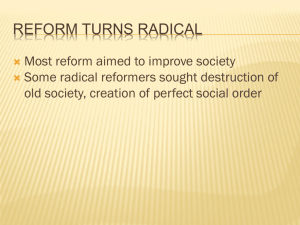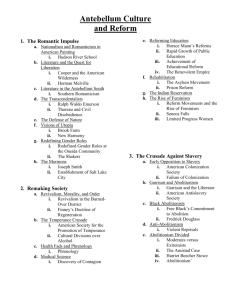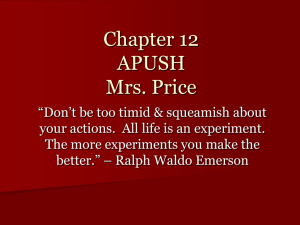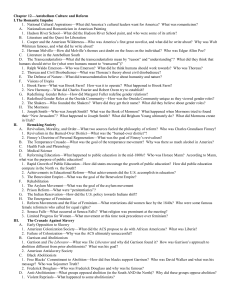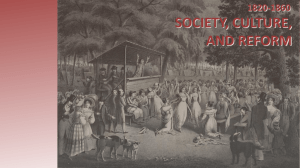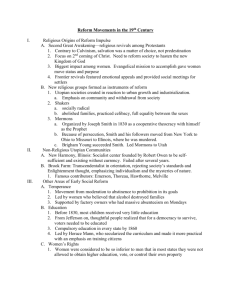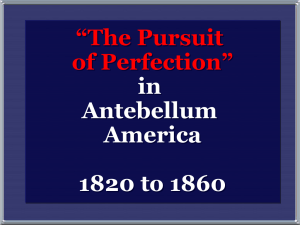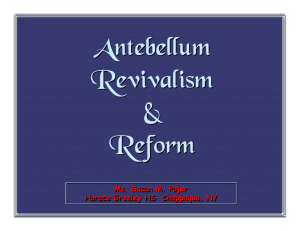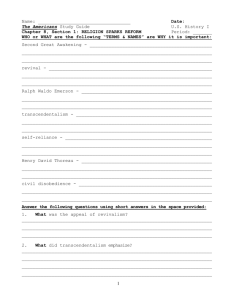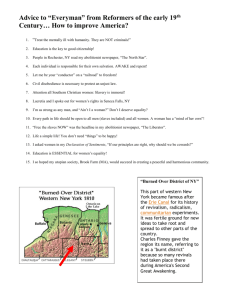Abolitionism
advertisement
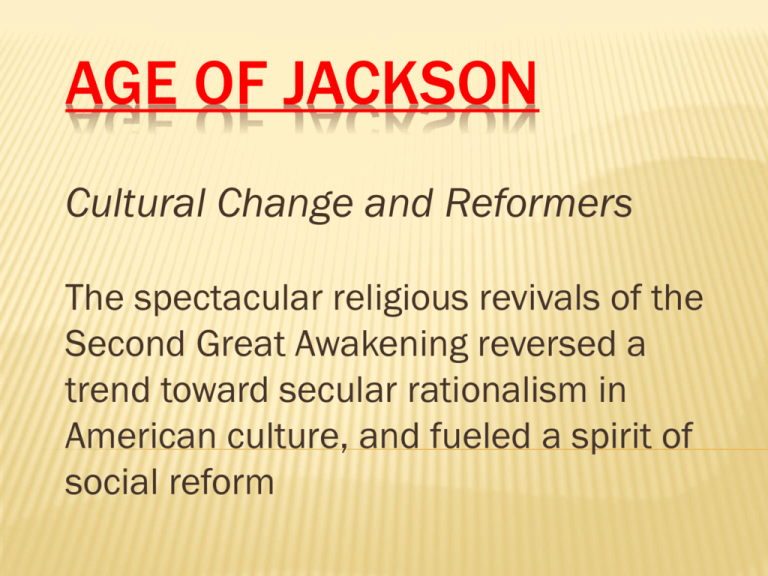
AGE OF JACKSON Cultural Change and Reformers The spectacular religious revivals of the Second Great Awakening reversed a trend toward secular rationalism in American culture, and fueled a spirit of social reform ERA OF REFORM 1790-1860 1794: Thomas Paine attacks hierarchical religion Deism and Unitarianism spreads COUNTER-REACTION is the Second Great Awakening (1800-1830’s) Reform Movements: 1. Evangelicalism 2. Prison Reform 3. Care of the mentally ill (Dorothy Dix) 4. Temperance (Neal Dow, Maine Law - 1851) 5. Women’s Movement 6. Abolitionism REVIVALISM http://www.gprep.org/~sjochs/reform-revival.jpg CHARLES G. FINNEY http://www.oberlin.edu/external/EOG/image s/CharlesGrandisonFinney.html REVIVALISM AND CLASS Revivals are: More common on frontier, South and West Less common among elites Creates more democratic churches, i.e. Methodists, Baptists, Adventists, etc. “Canary” for societal attitudes toward slavery: Churches Split, Parties Split, Union Splits. The spirit of optimism and reform affected nearly all areas of American life and culture, including education, the role of women and the family, and literature and the arts. FREE SCHOOLS Spread of Democracy Public Education Education Stability CATALYST: Universal white male suffrage Basic public schools spread 1825-1850 Horace Mann reforms/upgrades schools Webster’s “lessons” & McGuffey “readers” State supported colleges spread, esp.UVA NOTE: schools still rare in West and esp. for free African-Americans, slaves prohibited. Women struggle for equality in Education http://www.nd.edu/~rbarger/www7/cs9.jpg FREE SCHOOLS NOTE: Schools still rare in West and esp. for free African-Americans, slaves prohibited. Women also struggle for equality in Education. NOTABLE EXCEPTIONS: Emma Willard est. Troy Female Seminary Oberlin College Mary Lyon founds Mount Holyoke Seminary DEMOCRATIC CULTURE Artists’ audience was broad citizenry of democracy, not refined elite Romanticism in America appealed to feelings and intuitions of ordinary Americans DEMOCRATIC CULTURE Popular literature sensationalized Genres included Gothic horror and romantic fiction Much popular literature written by and for women Melodrama dominated popular theater By 1830s, subject of paintings switched from great events and people to scenes from everyday life LITERATURE Henry Wadsworth Longfellow, poet James Russell Lowell, poet Song of Hiawatha The Courtship of Miles Standish Bigelow Papers, re. Mexican War Oliver Wendell Holmes, writer Louisa May Alcott - Little Women Emily Dickinson, poet Edgar Allen Poe, author, “The Raven” William Gilmore Simms, Southern writer Nathaniel Hawthorne, The Scarlet Letter Herman Melville, Moby Dick DEMOCRATIC CULTURE Architectural style reflected the tenets of ancient Greek democracy Purpose of art in democratic society was to encourage virtue and proper sentiment Landscape painters believed representations of untamed nature would elevate popular taste and convey moral truth Only a few truly avant-garde, romantic artists, like Edgar Allan Poe http://www.metmuseum.org/special/Hudson_River/gifford_more.htm Thomas Cole, Falls of the Kaaterskill, 1826. Lake Nemi, 1856–57. Sanford Robinson Gifford (American, 1823–1880). “The Hudson River School, first identified at the end of its heyday, was a fraternity of artists who worked principally in New York City from about 1840 to 1875. Together, they raised landscape painting to preeminent status in America in the mid-nineteenth century. Originally attracted by the grandeur of natural scenery along the Hudson River and in New England, the painters interpreted both the wilderness and the pastoral face of a growing and changing nation.” ARTS AND SCIENCES Asa Gray, botanist James Audubon, naturalist Thomas Jefferson, philosophy and architecture Gilbert Stuart, painter Charles Wilson Peale, painter (from MD) John Trumbull, painter Hudson River School of painting Stephen C. Foster, American folk music Washington Irving, writer James Fenimore Cooper, writer William Cullen Bryant, poet TRANSCENDENTALISTS (1830’S) TRUTH IS NOT OBJECTIVE ALONE –DISCOVERED BY “INNER LIGHT” Individualism, Self-reliance, Self-Discipline Ralph Waldo Emerson, essayist Henry David Thoreau Walden Civil Disobedience Walt Whitman Leaves of Grass RADICAL IDEAS AND EXPERIMENTS: UTOPIAN COMMUNITIES Utopian socialism Inspired by Robert Owen, Charles Fourier New Harmony, Indiana—Owenite Fourierite phalanxes Religious utopianism Shakers Oneida Community Utopian Communities Before the Civil War UTOPIAS New Harmony, Indiana –fails Brook Farm, MA – transcendentalists – destroyed by fire Oneida Community, NY – eugenics, lasts 30 years – famous for metalwork Shakers, Mother Ann Lee, 1770’s – peak in 1840’s, slow decline after What is evidence of Shaker spirituality do you see in the pictures here? http://www.nationalgeographic.com/photography/galleries/shakers/index.html http://www.ohiohistory.org/places/shaker/images/shakers.gif THE SHAKERS JOSEPH SMITH AND THE MORMONS All American religion, created in US Mormons move from Ohio to Missouri & Illinois. Communitarian sect not popular Mormon militia arouses fear Polygamy unpopular 1844 Mormons flee Illinois after mobs murder Smith Brigham Young leads Mormons west to Utah, 1846-1847, est. frontier cooperative theocracy Conflict with federal govt. over polygamy, threatens fighting, over polygamy delays statehood to 1896 REFORM TURNS RADICAL Most reform aimed to improve society Some radical reformers sought destruction of old society, creation of perfect social order DIVISIONS IN THE BENEVOLENT EMPIRE Radical perfectionists impatient by 1830s, split from moderate reform Temperance movement Peace movement Antislavery movement Moderates sought gradual end to slavery and colonization of freed slaves to its colony of Liberia WOMEN’S CHANGING ROLES Women experience more freedom, esp. on frontier Lucretia Mott, Quaker, Abolitionist Elizabeth Cady Stanton, organizer Susan B. Anthony, lecturer Dr. Elizabeth Blackwell, first MD Margaret Fuller, editor 1848 “Declaration of Sentiments,” Seneca Falls, NY, “all men and women are created equal,” LAUNCHES WOMEN”S RIGHTS MOVEMENT DOMESTICITY AND CHANGES IN THE AMERICAN FAMILY New conception of family’s role in society Child-rearing seen as essential preparation for self-disciplined Christian life Women confined to domestic sphere Women assumed crucial role within home THE CULT OF DOMESTICITY “The Cult of True Womanhood” Placed women in the home Glorified home as center of all efforts to civilize and “Christianize” society Middle- and upper-class women became increasingly dedicated to the home as mothers Women of leisure entered reform movements MARRIAGE FOR LOVE Mutual love must characterize marriage Wives became more of a companion to their husbands and less of a servant Legally, the husband was the unchallenged head of the household THE DISCOVERY OF CHILDHOOD Nineteenth-century child the center of family Each child seen as unique, irreplaceable Ideal to form child’s character with affection Parental discipline to instill guilt, not fear Train child to learn self-discipline Family size declines from average of 7.04 children to 5.42 by 1850 ABOLITIONISM Roots in Second Great Awakening – see impact of Charles Grandison Finney BEFORE 1820 antislavery societies are more numerous in the South. Slave revolts end Southern toleration of abolition. 1835 Congress forbids use of mail to send abolitionist material through the mail. 1836 House of Reps passes the “gag rule,” John Quincy Adams defeats this in court after 8 yrs. South advances theory that slavery “civilizes” Africans, compares slave’s quality of life to “wage slaves” in the North FROM ABOLITIONISM TO WOMEN’S RIGHTS Abolitionism opened to women’s participation Involvement raised awareness of women’s inequality FROM ABOLITIONISM TO WOMEN’S RIGHTS Seneca Falls Convention in 1848 Organized by Lucretia Mott, Elizabeth Cady Stanton Prompted by experience of inequality in abolition movement Began movement for women’s rights SHIFT FROM GRADUALISM TO ABOLITIONISM Urgency of the Reform Movement following 2nd Great Awakening Increasing number of manumissions Failure of “Re-Colonization” efforts Tensions Increase following Turner’s 1831 Rebellion Free Blacks loose rights/sometimes freedom Impact of Garrison Propaganda War Gag Rule HTTP://WWW.LOC.GOV/EXHIBITS/AFRICAN/AFAM005.HTML This handbill urging opponents of abolitionists to obstruct an anti-slavery meeting demonstrates the depth of pro-slavery feeling. Although the handbill advocates peaceful means, violence sometimes erupted between the two factions. An emotion-laden handbill was a factor in the well-known Boston riot of October 21, 1835. In that incident, a mob broke into the hall where the Boston Female AntiSlavery Society was meeting, and threatened William Lloyd Garrison's life. "Outrage," February 2, 1837 Handbill DIVISIONS IN THE BENEVOLENT EMPIRE Radicals like William Lloyd Garrison demanded immediate emancipation 1831: Garrison founded The Liberator 1833: American Anti-Slavery Society THE ABOLITIONIST ENTERPRISE: PUBLIC RECEPTION Appealed to hard-working small town folk Opposition in cities and near Mason-Dixon line Opposition from the working class Disliked blacks Feared black economic and social competition Solid citizens saw abolitionists as anarchists THE ABOLITIONIST ENTERPRISE: THEODORE DWIGHT WELD Weld an itinerant minister converted by Finney Adapted his revivalist techniques to abolition Successful mass meetings in Ohio, New York BLACK ABOLITIONISTS Former slaves related the horrible realities of bondage Prominent figures included Frederick Douglass and Sojourner Truth Black newspapers, books, and pamphlets publicized abolitionism to a wider audience Blacks were also active in the Underground Railroad Free black from North Carolina DAVID WALKER Urged slaves to rise up and revolt for their freedom. Found dead outside of his printing office “Southern slave masters hated Walker and put a price on his head. In 1829, 50 unsolicited copies of Walker's Appeal were delivered to a black minister in Savannah, Ga. The frightened minister, understandably concerned for his welfare, informed the police. The police, in turn, informed the governor of Georgia. As a result, the state legislature met in secret session and passed a bill making the circulation of materials that might incite slaves to riot a capital offense. The legislature also offered a reward for Walker's capture, $10,000 alive and $1,000 dead.” http://www.africawithin.com/bios/david_walker.htm “I have been frequently asked how I felt when I found myself in a free state….It was a moment of the highest excitement I ever experienced…. This state of mind, however, very soon subsided; and I was again seized with a feeling of great insecurity and loneliness. I was yet liable to be taken back, and subjected to all the tortures of slavery. This in itself was enough to damp the ardor of my FREDERICK DOUGLASS (1817-1895) enthusiasm.” Narrative of the Life of Frederick Douglass, 1845 http://www.pbs.org/wgbh/aia/part4/images/4fred16m.jpg THE ABOLITIONIST ENTERPRISE: OBSTACLES Abolitionists hampered by infighting William Lloyd Garrison disrupted movement by associating with radical reform efforts Urged abolitionists to abstain from participating in the political process Also involved in women’s rights movement Some abolitionists helped form the Liberty Party in 1840 “ I am earnest – I will not equivocate – I will not excuse – I will not retreat a single inch – and I will be heard.” (The Liberator, 1831) http://www.loc.gov/exhibits/african/images/lib.jpg http://edison.rutgers.edu/latimer/wlg.htm WILLIAM LLOYD GARRISON (1805-1879) COMPARE AND CONTRAST GARRISON F. DOUGLASS DAVID WALKER
